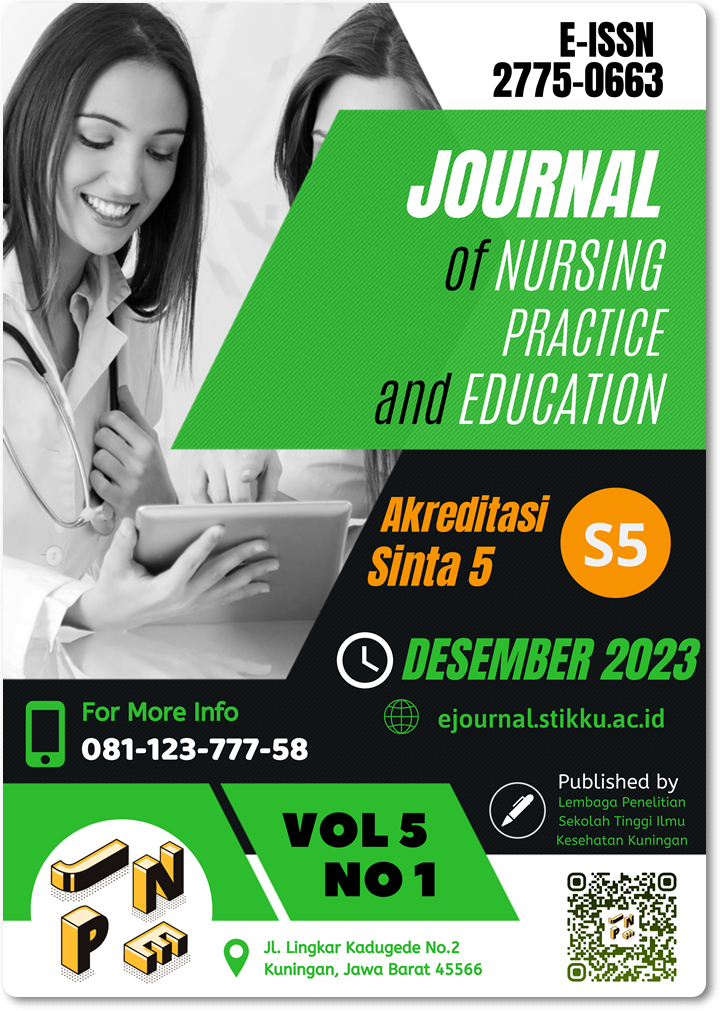Hubungan antara jenis kelamin dengan self harm pada remaja generasi z di sekolah menengah atas
DOI:
https://doi.org/10.34305/jnpe.v5i1.1450Keywords:
Jenis kelamin, kesehatan mental, generasi Z, remaja, self harmAbstract
Latar Belakang: Generasi Z cenderung menghadapi tekanan sosial dan psikologis yang lebih besar dibandingkan generasi sebelumnya. Studi menunjukkan prevalensi self-harm Gen Z yang lebih tinggi dibandingkan generasi sebelumnya. Penelitian ini bertujuan untuk menganalisis hubungan antara jenis kelamin dengan kejadian self harm pada remaja generasi Z di SMA X Kabupaten Kuningan.
Metode: Penelitian ini menggunakan metode cross sectional. Sampel dalam penelitian ini sebanyak 81 orang mengunakan teknik random sampling. Kuesioner penelitian ini menggunakan Delibrate Self harm Inventory (DSHI). Analisis data menggunakan chi square.
Hasil: Seluruh remaja, baik laki-laki maupun perempuan, pernah melakukan self-harm. Pada remaja laki-laki, mayoritas (74,1%) melakukan self harm dengan kategori rendah, sedangkan pada remaja perempuan, mayoritas (51,9%) melakukan self-harm dengan kategori tinggi. Hal ini menunjukkan bahwa jenis kelamin memengaruhi tingkat keparahan self harm, dengan perempuan lebih cenderung mengalami self-harm yang lebih serius. Temuan ini diperkuat oleh hasil analisis yang menunjukkan hubungan signifikan antara jenis kelamin dan kejadian self harm (p=0,026).
Kesimpulan: Terdapat hubungan signifikan antara jenis kelamin dan kejadian self harm.
References
Benavides, T. B. T., Castro, A. T. A., Marichalar, S. A. G., Cisneros, M. P., & Suárez, E. C. B. (2023). Social Media Addiction in Generation Z Consumers. SpringerBriefs in Business.
Brereton, A., & McGlinchey, E. (2020). Self-harm, emotion regulation, and experiential avoidance: A systematic review. Archives of Suicide Research, 24(sup1), 1–24.
Bresin, K., & Schoenleber, M. (2015). Gender differences in the prevalence of nonsuicidal self-injury: A meta-analysis. Clinical Psychology Review, 38, 55–64.
Kalangi, P., Rempowatu, F., Tumewu, V., & Ilat, I. P. (2024). Self Harming Pada Remaja. Jurnal Pendidikan Agama Kristen, 5(1), 40–49. https://doi.org/https://doi.org/10.51667/djpk.v5i1.1853
Keles, B., McCrae, N., & Grealish, A. (2020). A systematic review: the influence of social media on depression, anxiety and psychological distress in adolescents. International Journal of Adolescence and Youth, 25(1), 79–93.
Kemenkes, R. I. (2019). Laporan Nasional Riskesdas 2018. Badan Penelitian Dan Pengembangan Kesehatan. Lembaga Penerbit Badan Penelitian Dan Pengembangan Kesehatan.
Kuehner, C. (2017). Why is depression more common among women than among men? The Lancet Psychiatry, 4(2), 146–158.
Lim, K.-S., Wong, C. H., McIntyre, R. S., Wang, J., Zhang, Z., Tran, B. X., Tan, W., Ho, C. S., & Ho, R. C. (2019). Global lifetime and 12-month prevalence of suicidal behavior, deliberate self-harm and non-suicidal self-injury in children and adolescents between 1989 and 2018: a meta-analysis. International Journal of Environmental Research and Public Health, 16(22), 4581.
Marchant, A., Hawton, K., Stewart, A., Montgomery, P., Singaravelu, V., Lloyd, K., Purdy, N., Daine, K., & John, A. (2017). A systematic review of the relationship between internet use, self-harm and suicidal behaviour in young people: The good, the bad and the unknown. PloS One, 12(8), e0181722.
Orben, A., Tomova, L., & Blakemore, S.-J. (2020). The effects of social deprivation on adolescent development and mental health. The Lancet Child & Adolescent Health, 4(8), 634–640.
Tang, D., Mair, C. A., & Hu, Q. (2023). Widowhood, social networks, and mental health among Chinese older adults: The moderating effects of gender. Frontiers in Psychology, 14, 1142036.
Twenge, J. M., Joiner, T. E., Rogers, M. L., & Martin, G. N. (2018). Increases in depressive symptoms, suicide-related outcomes, and suicide rates among US adolescents after 2010 and links to increased new media screen time. Clinical Psychological Science, 6(1), 3–17.
Viner, R., Russell, S., Saulle, R., Croker, H., Stansfeld, C., Packer, J., Nicholls, D., Goddings, A.-L., Bonell, C., & Hudson, L. (2021). Impacts of school closures on physical and mental health of children and young people: a systematic review. MedRxiv, 2002–2021.
Wilkinson, P., Kelvin, R., Roberts, C., Dubicka, B., & Goodyer, I. (2011). Clinical and psychosocial predictors of suicide attempts and nonsuicidal self-injury in the Adolescent Depression Antidepressants and Psychotherapy Trial (ADAPT). American Journal of Psychiatry, 168(5), 495–501.
Yuliyana, Sinring, A., & Juwarningsih. (2023). Cognitive Behavior Therapy dengan Teknik Rekonstruksi Kogntif Untuk Mengurangi Perilaku Self-Harm Peserta Didik Di SMAN 2 Tarakan. Jurnal Pemikiran Dan Pengembangan Pembelajaran, 5(3), 229–234. https://doi.org/https://doi.org/10.31970/pendidikan.v5i3.935
Downloads
Published
How to Cite
Issue
Section
License
Copyright (c) 2024 Nur Wulan, Moch. Didik Nugraha

This work is licensed under a Creative Commons Attribution 4.0 International License.
Journal of Nursing Practice and Education published under the terms of a Creative Commons Attribution 4.0 International License / CC BY 4.0 This license permits anyone to copy and redistribute this material in any form or format, compose, modify, and make derivative works of this material for any purpose, including commercial purposes, so long as they include credit to the Author of the original work.
This work is licensed under a Creative Commons Attribution 4.0 International License / CC BY 4.0





